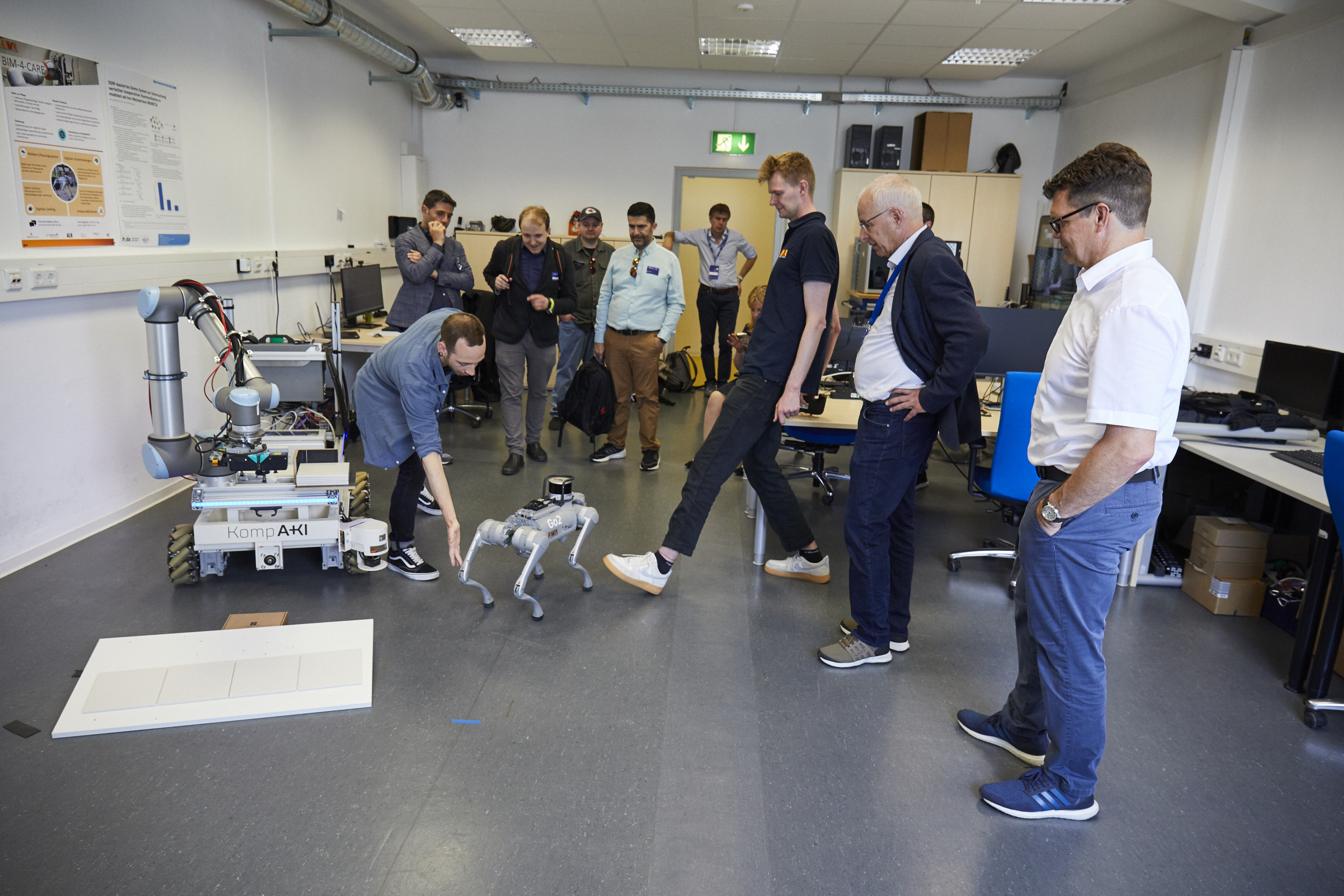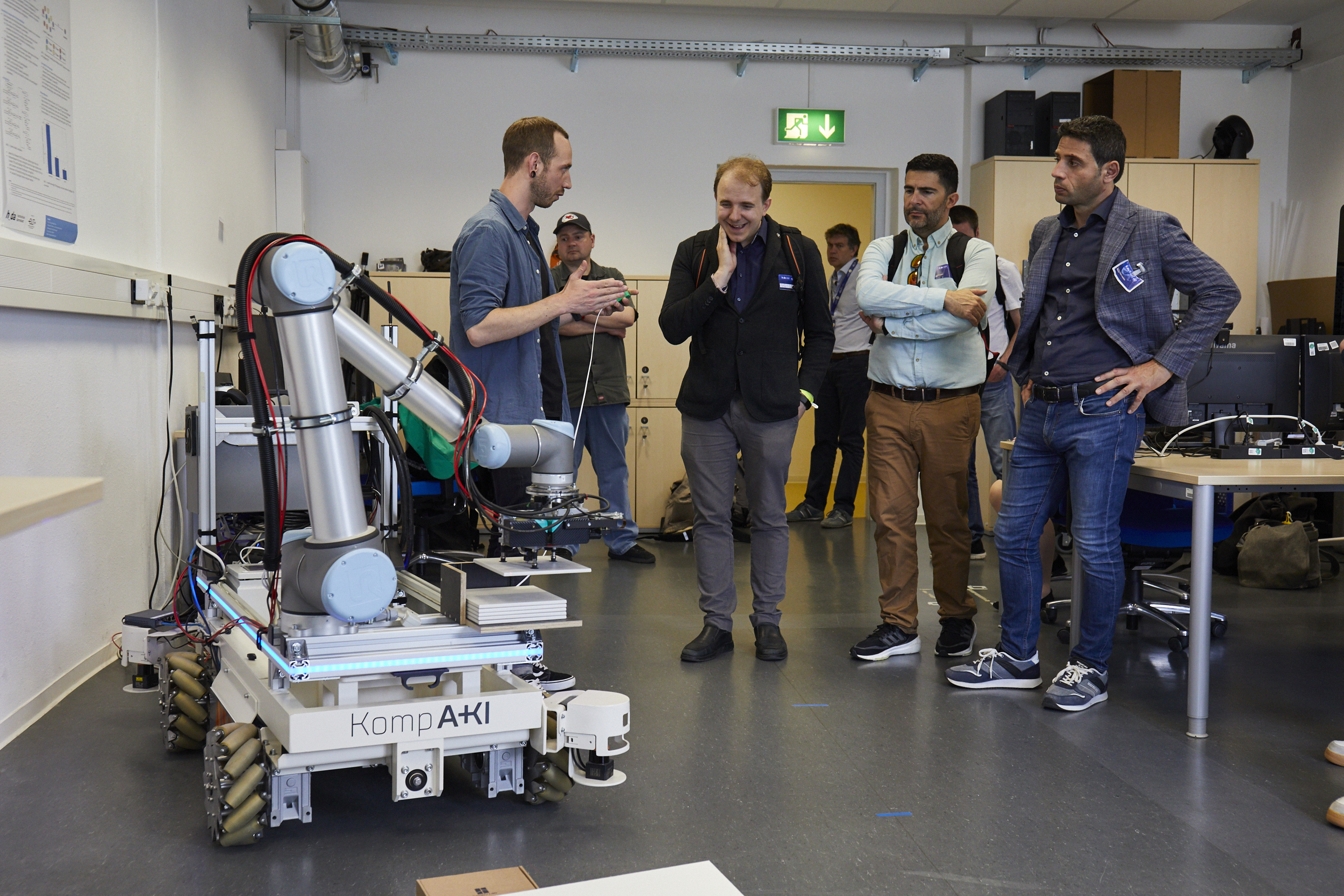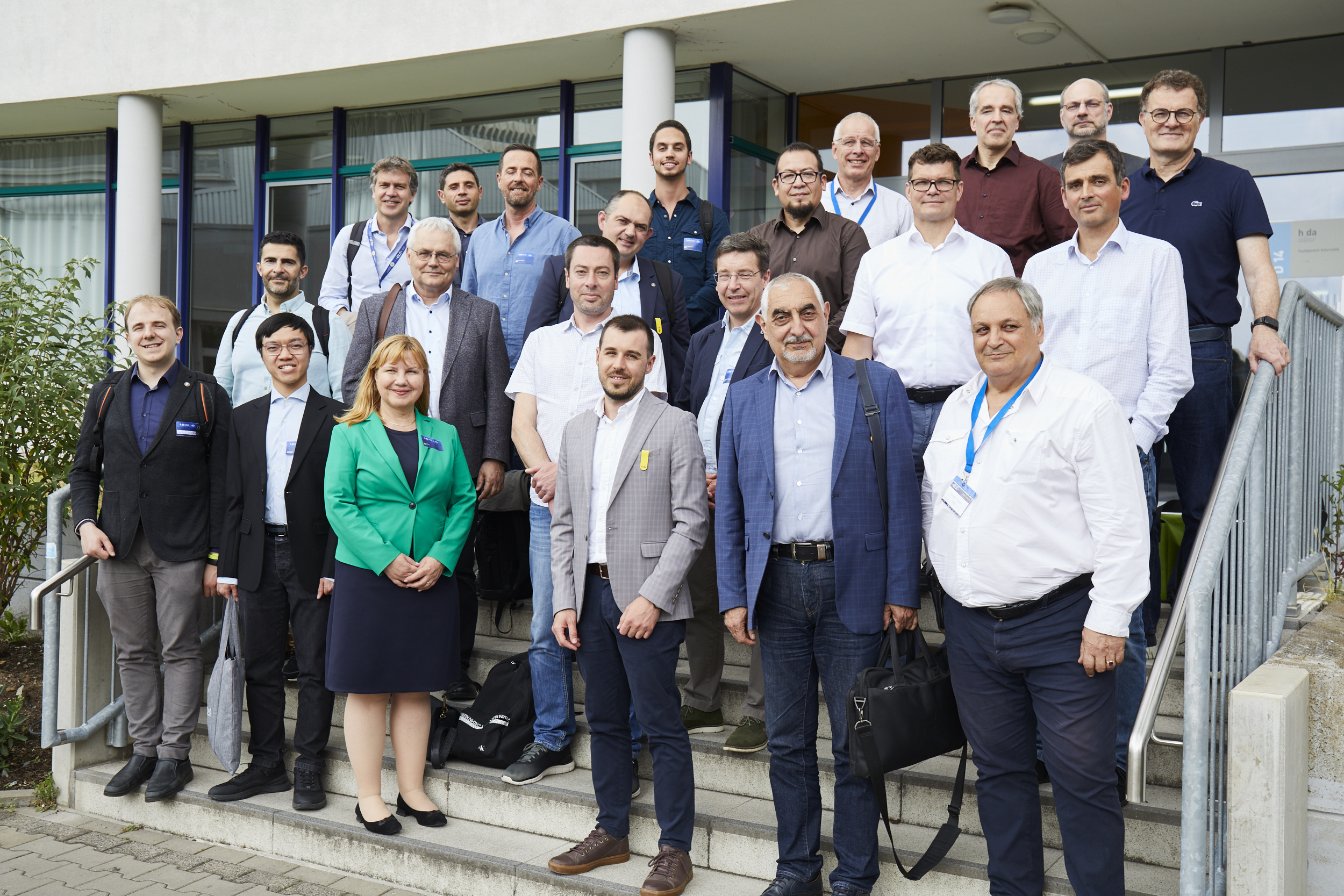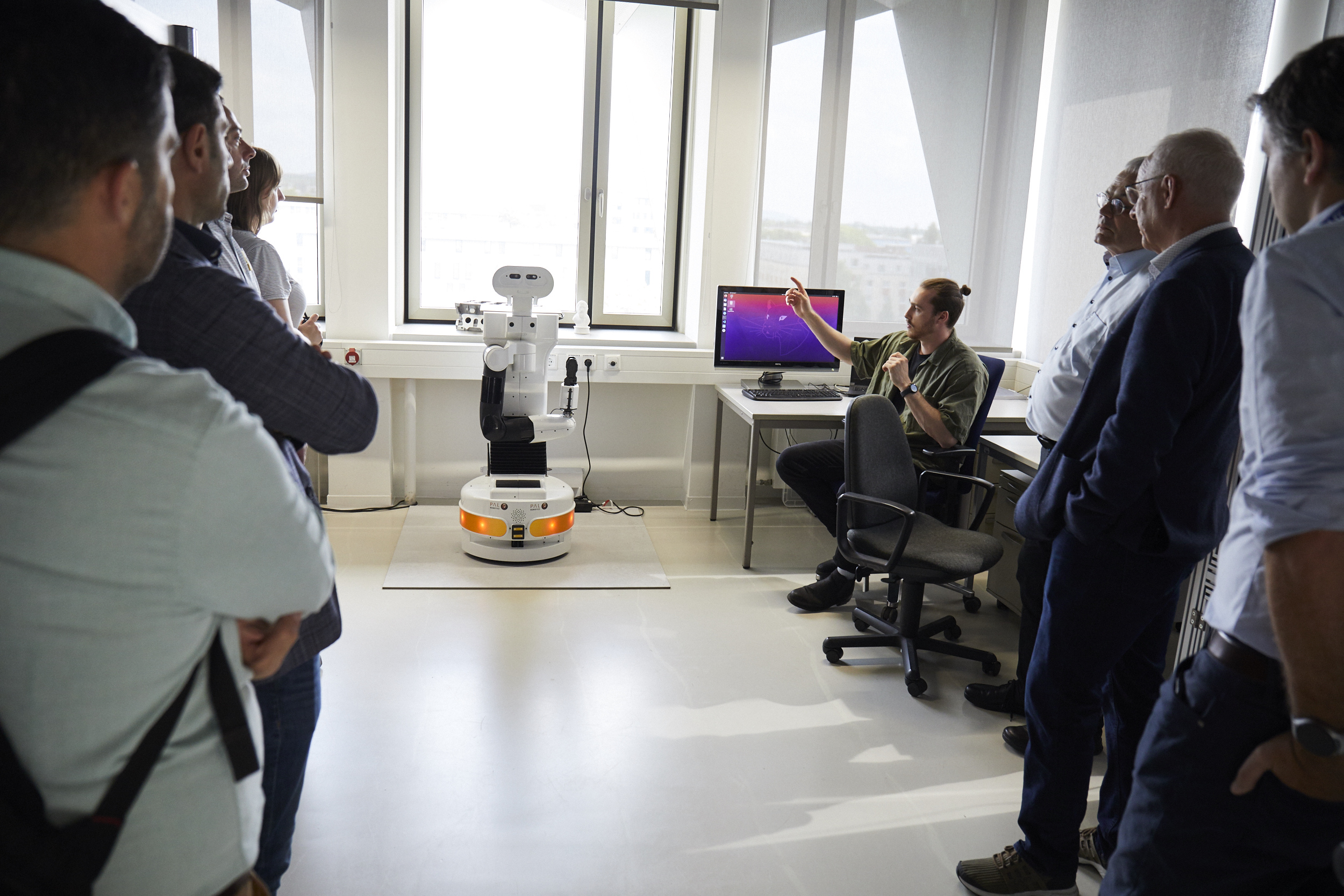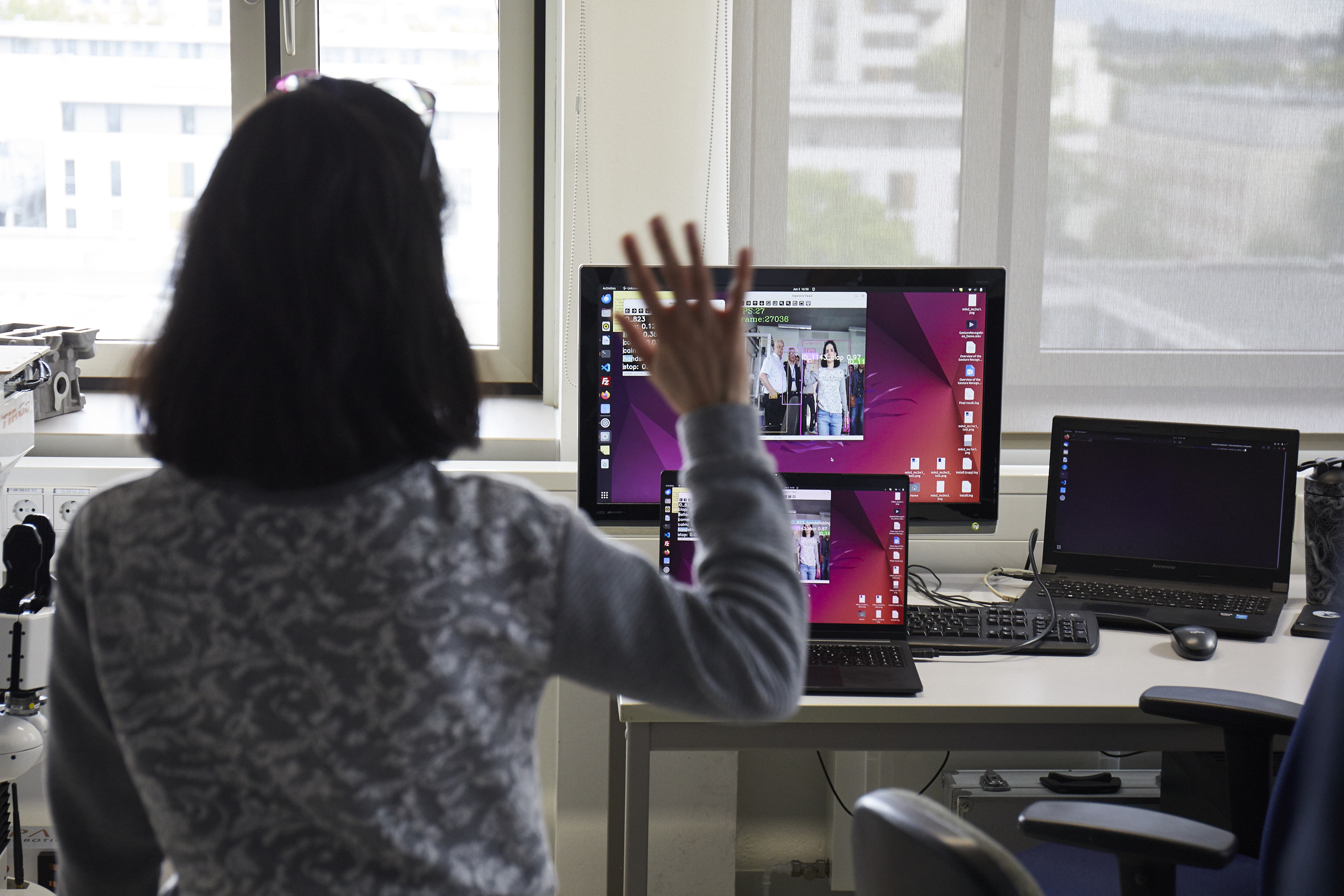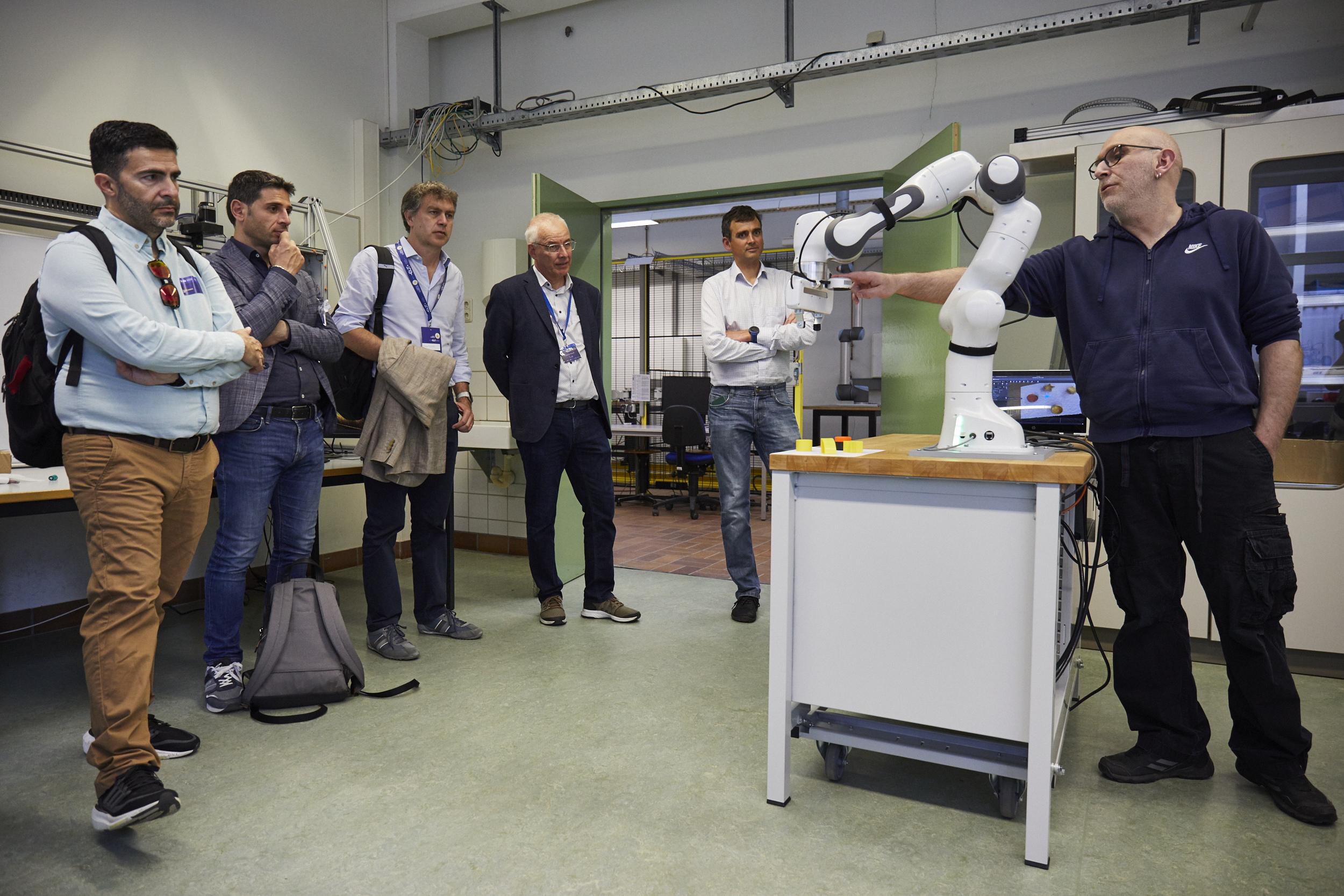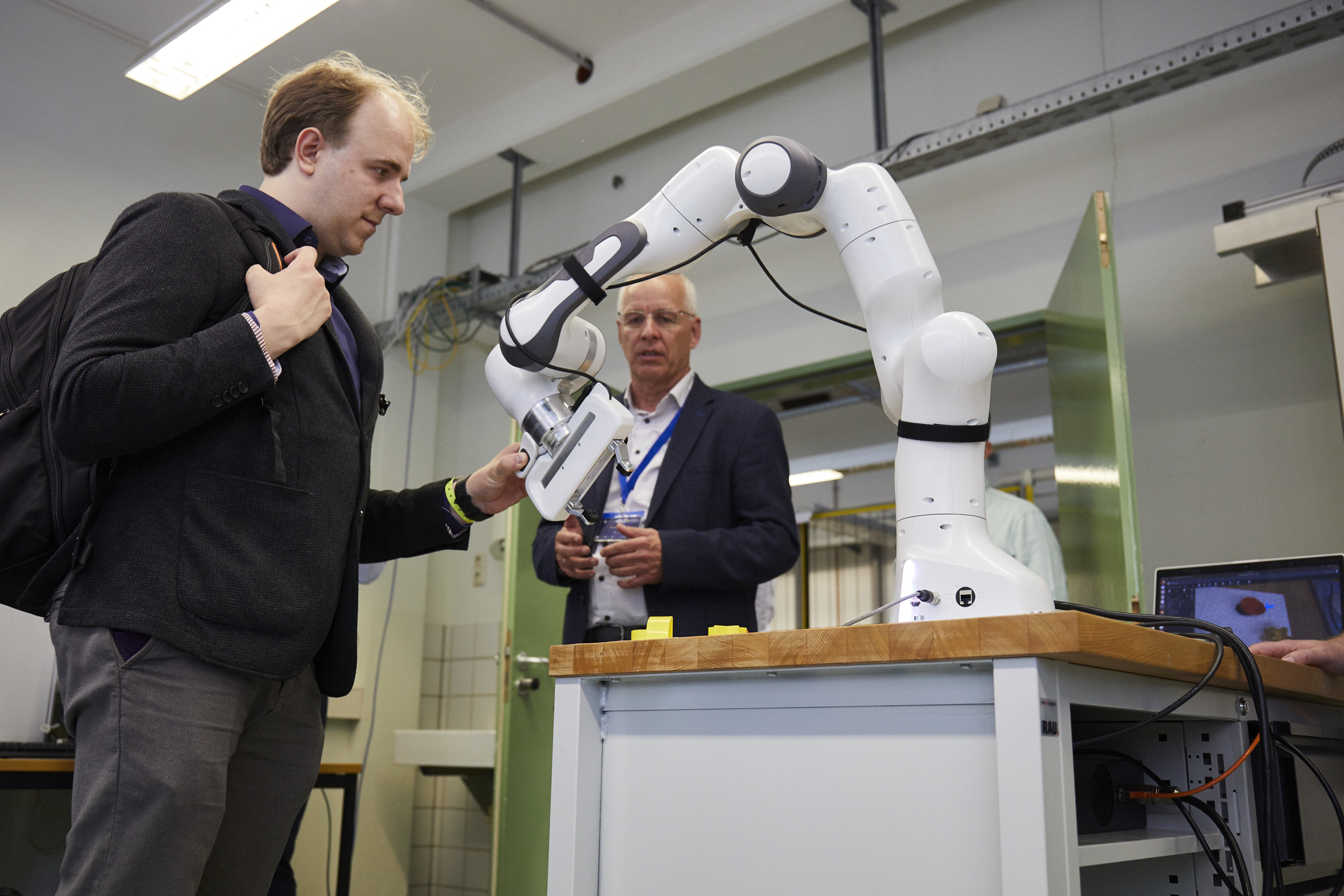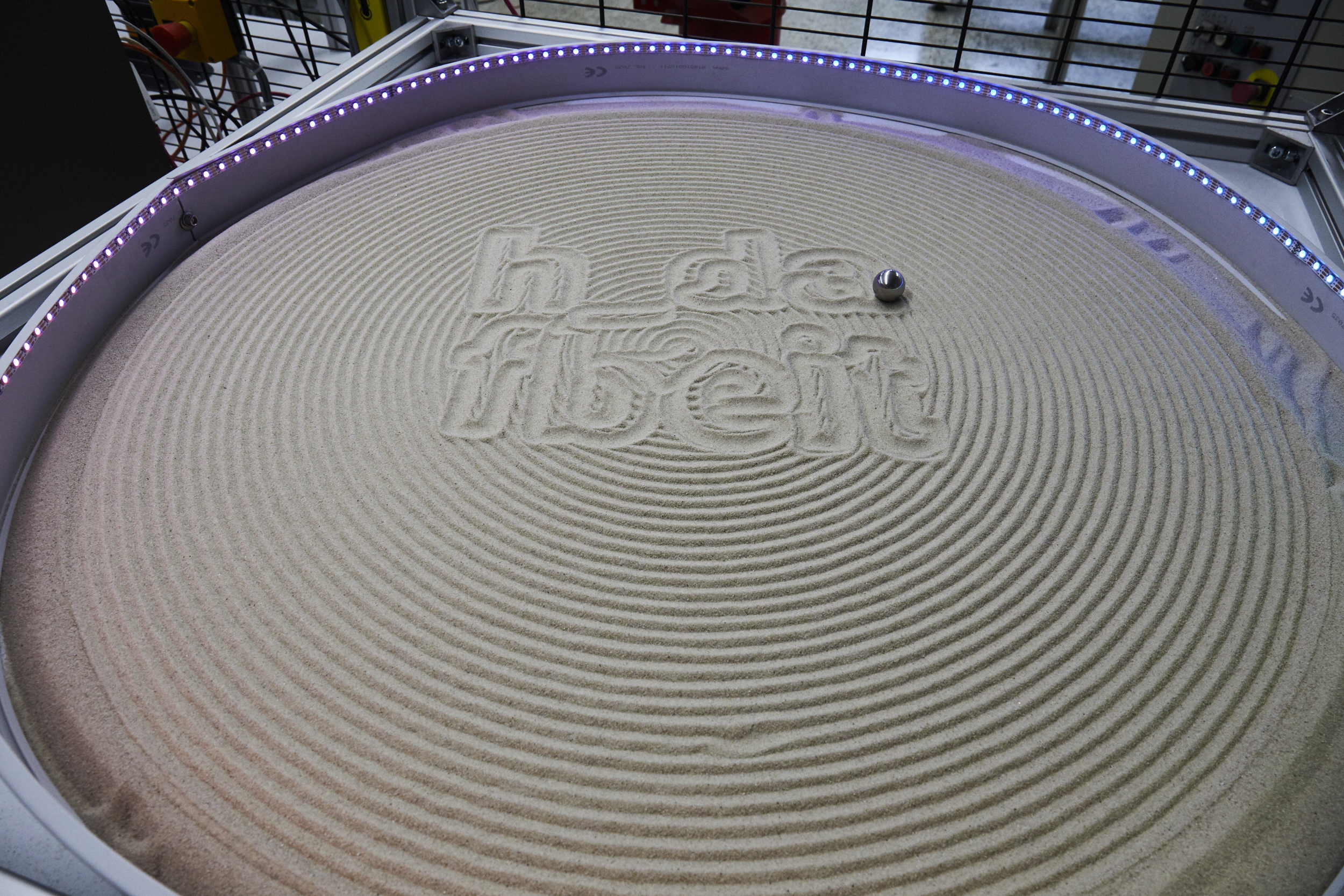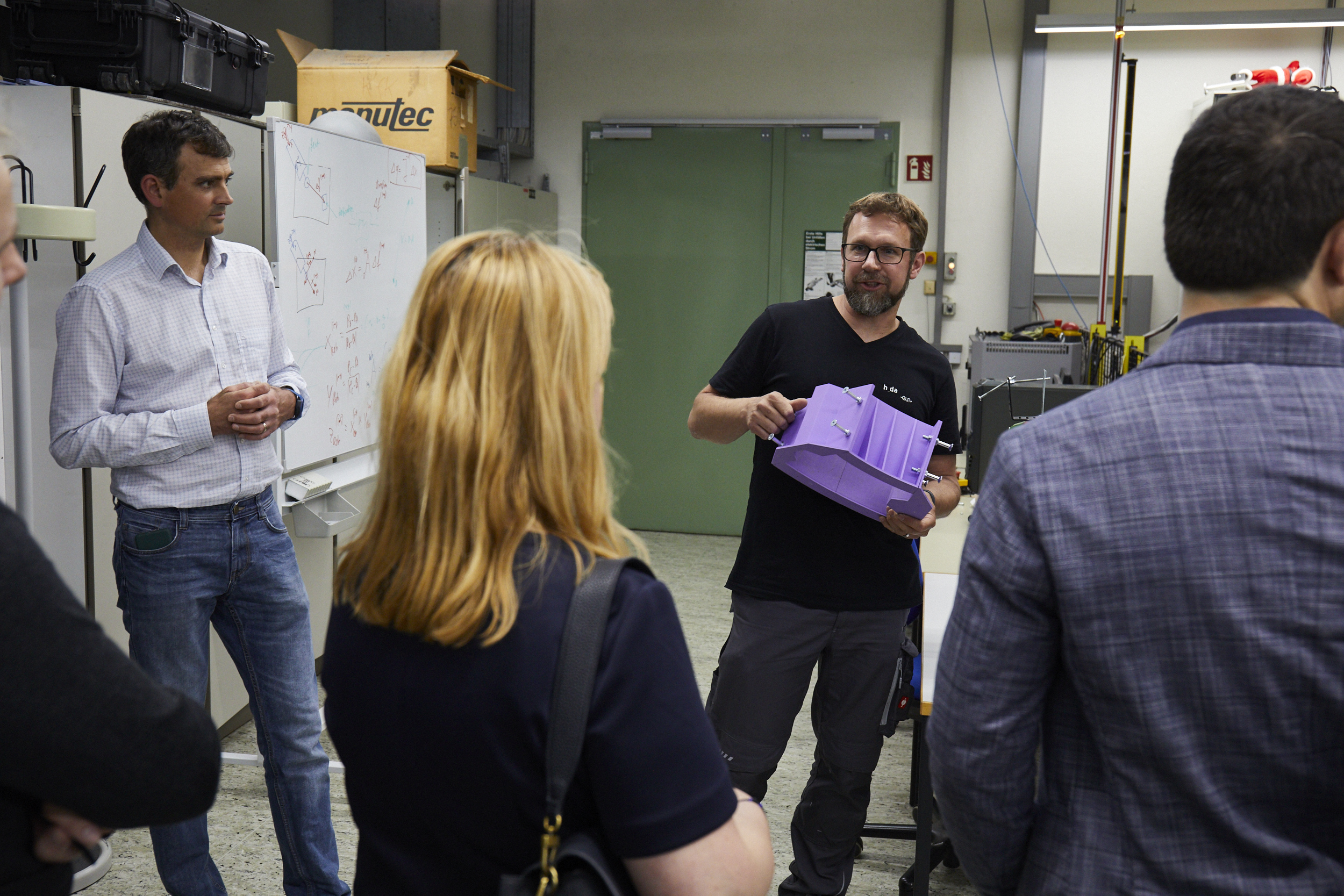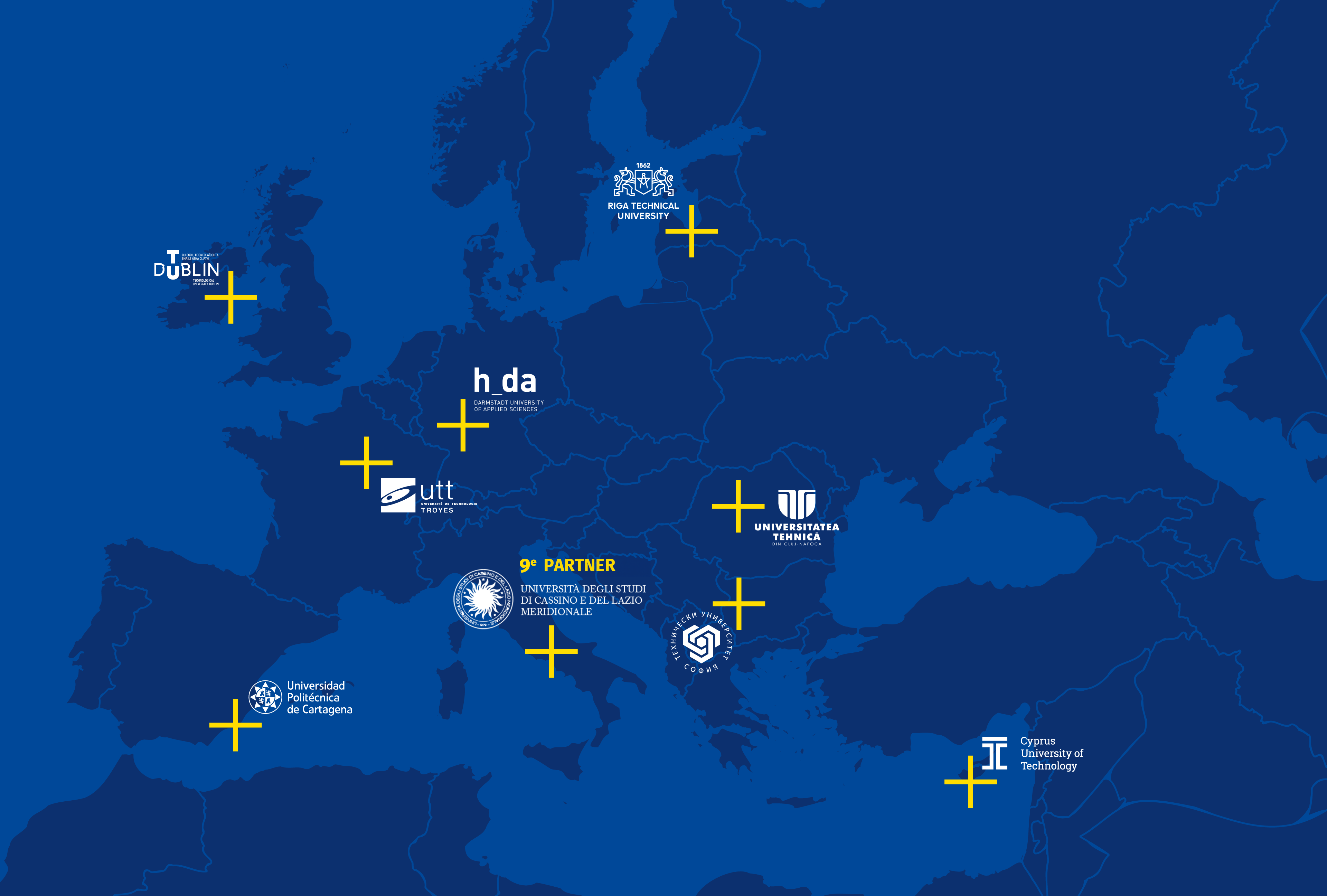EUT European Robotics Workshop
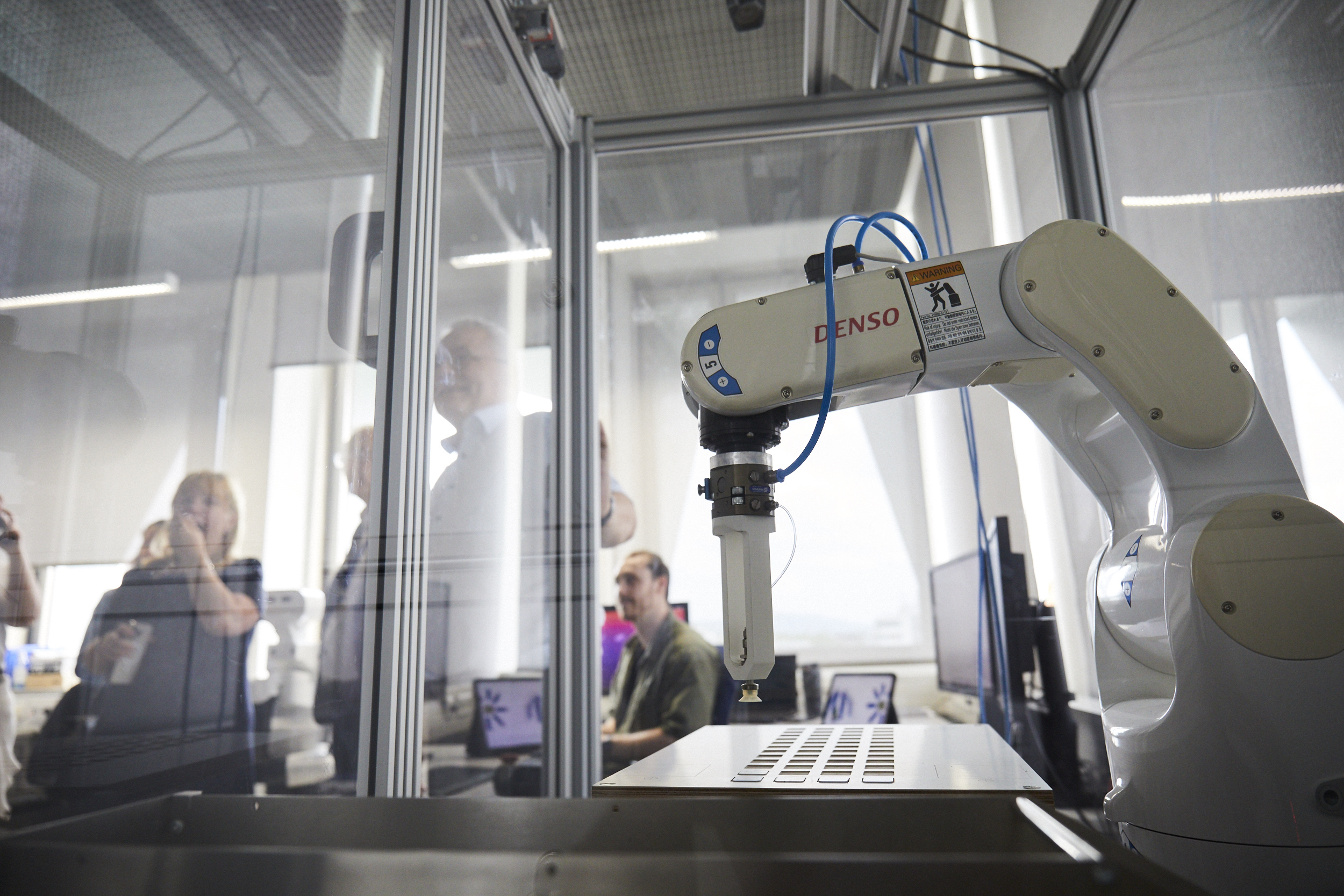
The European University of Technology (EUT+) is growing ever closer together: scientists from the alliance have already set up international research groups on various topics, such as nanotechnology, data science and sustainability science. Such a research group is now on the agenda again, this time in robotics. That is why around 20 experts from the nine EUT+ partner universities came together on the campus of Darmstadt University of Applied Sciences (h_da) at the beginning of June – to get to know each other in person, identify common topics and forge plans for teaching and research projects at European level. The meeting took place as part of “EUT+ Darmstadt Week”, one of the university alliance’s several intensive working sessions this year.
By Christina Janssen, 9.6.2025
“I promise he won’t bite you!” jokes Till Weist at the demonstration of the robot dog, which the junior researcher lets loose in the laboratory. It runs and jumps around, controlled by a console he is holding in his hands. Although his four-legged friend cannot bark nor excitedly wag its tail due to the lack of the corresponding body part, it nevertheless looks surprisingly like a little dog. “It’s fun stuff,” according to the team led by Professor Sven Rogalski at h_da’s Faculty of Electrical Engineering and Information Technology. But, of course, the robot dog also has serious tasks to perform: “It’s intended above all for use in the construction industry,” explains robotics expert Rogalski. “With the help of integrated cameras and sensors, it can measure buildings accurately and record structural details.” Rogalski’s laboratory is one of three stops on the “Lab Tour”, on which the group of around 20 scientists from all over Europe has embarked together.
They are all teaching and conducting research at one of the nine partner universities in the “European University of Technology (EUT+)” alliance. And they are extremely interested in their colleagues’ work. When doctoral student Leon Pfennig demonstrates a robot that can lay tiles and by so doing could prevent countless slipped discs on construction sites, a discussion rapidly unfolds: one colleague wants to know how long it took to programme the fine motion sequences. How might the robot’s further development look? How much interest is there in industry...?
Robotics is a broad field and C-3PO, the timid humanoid from Star Wars, almost a reality: from simple robots that mow the lawn to assembly robots in car factories to surgical robots in medicine or care robots in retirement homes – the areas of application appear infinite. That is why the list of topics that occupied robotics researchers during EUT+ Darmstadt Week was almost as long as the list of participants: the design, mechanics and control of robots, the use of artificial intelligence, interaction between humans and robots, robots in industry, medicine, aerospace or marine research. “Soft robotics” is a further topic – robots made of softer materials that are nicer “to touch” or even look more like humans.
The organisers, Professor Thomas Horsch, Professor Stephan Neser and Professor Karl Kleinmann from h_da, hosted their colleagues from Romania, Bulgaria, Italy, France, Spain, Cyprus, Ireland and Latvia. The aim, first of all, was to share expertise and get to know each other in person. The workshop might then sow the seed for a “European Research Group”.
“We have a good common basis,” finds Professor Thomas Horsch, who heads the robotics laboratory at h_da’s Faculty of Computer Science. Apart from many subject areas that overlap, there are also ones where they complement each other, endorses his Italian colleague Professor Filippo Arrichiello. “It’s a very good starting point.” In the next step, explains Professor Doina Pisla, Director of the Research Center for Industrial Robots Simulation and Testing (CESTER) at the EUT+ partner university in Cluj-Napoca, Romania, the group wants to develop short and long-term strategies for collaboration in teaching and research. “Were we to join forces, we could make a big impact in the robotics community.” Pisla, an expert in medical robotics, is the only woman to attend the meeting. When asked about this, she laughs: “I know lots of women in the robotics community, and I’ve got great female colleagues at my university too.”
The lab tour takes the group all over h_da’s campus. In University Tower, physicist Professor Stephan Neser explains the role of computer vision in robotics. The Tiago robot, on which his team is working, can recognise people, talk to them and read their mood from their facial expressions. The maxim is “Be happy!” “The system already recognises a happy face every time,” Neser is pleased to report. Master’s student Shahla Sadeghzadehdarandash from the University of Padua, a guest researcher in Neser’s lab for six months, is working on the robot’s ability to recognise, interpret and respond appropriately to gestures too. Shaking an outstretched hand, a friendly wave back – that the objective here is the interaction between humans and machines, for example in care or the restaurant trade, is clear to see. In addition, the Tiago robot is being further developed so that it can produce virtual 3D models: to do this, it autonomously circles an object and creates sets from countless image data, which are then assembled to a digital twin of the object – whether it be a racing car or an ancient temple. Among other applications, the technology could be used to digitise cultural sites – a topic on which a team from h_da has been working for several years in the Middle East.
The EUT+ research group is already contemplating various topics for potential collaborations – such as human-robot interaction (HRI) or assistive robots for the social sector. “Robotics is an interdisciplinary field,” says Professor Filippo Arrichiello from Cassino, who specialises in underwater robotics. “Our colleagues come from mechanical engineering, computer science, artificial intelligence, control engineering and medical technology. This enables us to contribute very different expertise to one and the same research area.”
The “Lab Tour” also reflects this diversity. The third stop is the largest robotics lab at h_da. Here, Rudi Scheitler from Professor Thomas Horsch’s team demonstrates a Panda robot. This robot with a gripper arm has a special feature: “It senses when you touch it,” explains Scheitler. And the sensitive little robot by no means likes being touched all too firmly: when Karlis Berkolds from Riga moves the multi-jointed gripper arm a little too forcefully, the robot switches off. The “Panda” is used in human-robot interaction. It recognises objects, can grasp and use them. For the group’s amusement, Scheitler lets it fiddle with a saltshaker. Its movements are astoundingly filigree. “The gripper is very easy to handle,” explains Professor Thomas Horsch, “which makes things very convenient for factory workers, for example.
In the room next door, Dr Heiko Koch from the Faculty of Electrical Engineering and Information Technology is already waiting to demonstrate industrial robots capable of exerting great force. That is why they are behind bars – like prison inmates. The aim is to use one of the robots in a collaborative project with the Faculty of Architecture to produce innovative bricks from a mixture of clay and stone. During this part of the tour, the researchers’ discussions with their guests revolve around control systems and safety in the laboratory. “We’ve never had any accidents here involving humans,” Koch assures the group, “but by all means cases where the robots have damaged themselves.” Robots that wreak havoc – another aspect of robotics research.
That the participants are highly enthusiastic about their subject is immediately noticeable. Filippo Arrichiello, whose specialist field seems rather exotic at first glance, lists the practical applications of underwater robots: “They are needed for marine biology, archaeology and geology, for environmental monitoring, for fishing garbage out of the oceans or on underwater construction sites.” Just as it was for his German colleague Thomas Horsch and Professor Pisla from Cluj-Napoca, it was clear to him after his first encounter with robotics: This is what it’s all about!
It was Thomas Horsch, a computer scientist involved in the alliance from the very outset, who came up with the idea for the first EUT+ robotics meeting. He is just as passionate about the international aspect as about his subject: “As a computer scientist, you mostly sit at a computer, nothing haptic or visual happens. In robotics it’s completely different: here you can touch things, move them, you’re thrilled when a robot manages to pick up an empty bottle and throw it in the bin. That has always fascinated me. And I find EUT+ and the idea behind it tremendous.” He is clearly not alone.
More impact articles on robotics
impact, 14.6.2024: “Who let the dogs out?”
impact, 27.1.2020: “Helluva good mate!”
Contact our Scientific Editorial Team
Christina Janssen
Science Editor
University Communications
Tel.: +49.6151.533-60112
Email: christina.janssen@h-da.de
Translation: Sharon Oranski
Photography: Jens Stengaesser
Links
Professor Filippo Arrichiello's website
Professor Thomas Horsch’s website
Lecture by Professor Thomas Horsch
Professor Karl Kleinmann's website (in German)
Professor Stefan Neser on LinkedIn
Professor Doina Pisla's website
Professor Sven Rogalski's website (in German)
European Universities Initiative
European University of Technology
